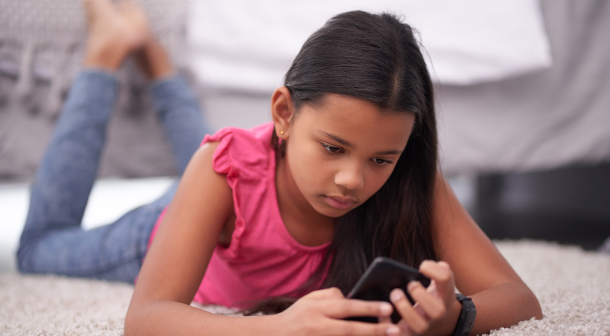Screens are part of everyday life as you text, scroll through social media, map a route, catch up on news, chat or shop online, relax with a video, and do so much more. Many adults spend 11 hours a day or more in front of a computer, phone, tablet, TV, or another type of screen.
Screens are also becoming a bigger part of life for young children. It's easy to let a fussy toddler play a game on your smartphone or turn on a preschooler's favorite video while you get dinner on the table. Screens are a source of education and entertainment for young children, not to mention a handy way to video chat with friends and family.
However, as a parent, you probably recognize that unlimited screen time is not a good idea for young children. How much screen time should you allow? How should you set screen time limits that work for your family? Setting boundaries for screen time is important for the entire family.

Did You Know
First, your instinct is right — unlimited screen time is not healthy for young children. Spending too much time on a screen can affect a young child's brain development and cause problems with attention, learning, and critical thinking skills, according to the National Library of Medicine. Beyond that, sitting in front of a screen takes away time children need for important activities like playing with toys, running around, looking at books, and interacting with siblings or other kids. Children learn important skills “in real life” rather than watching them on a screen. So, setting screen time limits is something all parents should consider.
In addition to missing out on non-screen activities, young children can be exposed to content that is scary or confusing. For example, games or videos may show parents leaving their children alone or show children being rewarded for misbehavior. Children thrive when they feel safe and secure and have clear and consistent guidelines about behavior. Setting boundaries will help protect children from inappropriate content and make sure they have time for age-appropriate activities.
Screen Time Recommendations by Age
The National Heart, Blood, and Lung Institute (NHBLI) recommends limiting screen time to two hours or less each day. Parents and caregivers can set rules that limit time spent on the computer and TV, including playing video games.
Every family is different, and you need a screen time plan that works for you. Try using the NHBLI screen time log to track how much time your children spend watching TV, playing video games, and sitting in from of the computer. This will help you identify any changes your family may want to consider to your use of screens.
Creating a family media plan is a great way to limit screen time - but give yourself a break if things don't always go right. Some days may be so hectic that you allow your kids more screen time than usual. That's OK! Once you've created a family media plan, you'll have a good feel for games and programs that are at the right developmental level for your kids and you can relax about it.

Screen Time Do's and Don'ts
Here are some guidelines to help you make screen time safe and healthy for young children. The key is to be intentional about what your child views and for how long each day.
Do
- Choose high-quality games and educational programs that are appropriate for your child's development. For example, toddlers respond to interactive games that feature shapes, colors, and animals, while older children may enjoy games involving counting, drawing, or exploring nature. Choose videos and games that are simple, colorful, and suited to your child's interest and attention. Lots of products claim to be educational for young children, but not all are. Common Sense media is a good source for information about online resources for kids.
- Use screen time to interact with your child and teach lessons about the world. Make screen time a shared activity as much as possible. Talk about the programs you watch and teach what is appropriate.
- Schedule plenty of non-screen time into your child's day. Children learn and grow through unstructured play time and physical activity. Screen time should be an add-on rather than a replacement for these important activities.
- Designate media-free zones and times. Screen time has its place, but there are places and times where screens don't belong. Put all screens away during mealtimes, family outings, and 30 minutes to an hour before bedtime. Try setting up one spot in the house where rechargeable devices are plugged in overnight.
- Set a good example. The most powerful parenting tool you have is to model the behavior you want to see in your children. Pay attention to your media habits and see whether you are setting a positive example. If you are constantly on your phone, chances are your child will also want to be on a screen as much as possible.
Don't
- Let a young child choose games or programming unless you have reviewed and approved them. Do your research before you share a program or game with your child.
- Leave the TV on as white noise or let your child spend time alone staring at a screen. One danger of unsupervised screen time is that children get used to being passive viewers, which can set up bad habits as they get older. Help them make good habits by limiting what they watch and for how long.
- Put a TV or internet-connected screen in your child's bedroom. Internet-connected devices should be in the public areas of the house, such as the living room, so you can supervise their use.
Need parenting help now?
The Texas Parent Helpline is available 24/7.
- Call 833-680-0611
- Chat with us
- Text 833-680-0611

4 Tips for Parents
Creating a family media plan helps you set safe and healthy screen time boundaries for young children. It also lays the foundation for healthy media use as children get older and have more independence. Here are 4 tips to help you set and keep screen time limits.
-
Set age-appropriate screen time limits for your children
- Develop a personalized media plan for each child based on their age and development. Start when your children are young, and post everyone's media plan on the refrigerator or a bulletin board.
- Revise the plan as they get older. Kids will get used to having a media plan and know what their screen time limits are. As they get older, you can talk with your kids about the plan and give them a chance to contribute.
- Communicate your plan to other caregivers, such as babysitters or grandparents, so rules are followed consistently. For example, make it clear that children are not allowed to view screens on their own, identify games or programs kids are allowed to view and for how long, and make them aware of the amount of screen time kids are allowed to have.
-
Become an informed consumer
- Research age-appropriate games and programs. Become familiar with ratings such as EC (early childhood) and E (everyone). Keep a list of approved games and programs your child can view.
- Learn about and use parental control settings that allow you to control what features your child can access.
- Limit your child's exposure to games and programming that are supported by advertising. Young children don't understand the difference between a program and an ad, especially one that features a character they like. Older kids may also need to be reminded that ads are intended to sell products.
- Make sure privacy settings are at their highest level on all devices to protect your child.
-
Prioritize activities that don't include screen time
- Make sure young children have plenty of time for creative play, physical activity, and rest. Kids who consistently watch a lot of TV tend to get less exercise and are more likely to be overweight. Games and programs can also feature violent acts or aggressive behavior that can scare young children or cause them to act out.
-
Set a good example
- Put away your digital devices during mealtimes and family outings, and limit screen time use around your kids.
- Try not to watch your favorite programs when young children are in the room. Having the TV on turns a screen into “background noise” and can unintentionally expose young children to inappropriate content or advertising.
Screens are part of everyone's daily life, and it's not realistic to keep young children away from screens all the time. However, limiting what kids are exposed to, and for how long, gives them plenty of time for healthy activities and encourages them to have a healthy relationship with media as they get older. If you are concerned about your child's screen time or how he reacts to games or programs, talk to your pediatrician or family physician.

For More Information
- Common Sense Media is a nonprofit focused on families and the media, with resources also available in Spanish.
- Parent Tips: We Can! Screen Time Chart. Use the National Institute of Health's “Screen Time Chart” and “Tips to Reduce Screen Time” to help plan your family's screen schedule.




